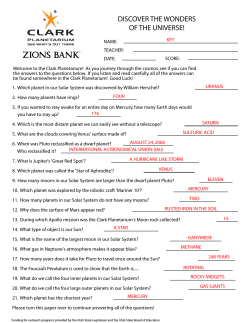
Solar System WebQuest Worksheet
Name_______________________ Date___________________ Period____________ Solar System WebQuest Worksheet The solar system consists of the Sun and objects that orbit it, which include planets, dwarf planets, asteroids, comets, and meteoroids. Each of these objects is defined and classified using a set of characteristics that distinguish each type of object from the others. This WebQuest will help you understand the solar system. You will need to read the information available on the webpages you visit. All answers can be found using one or more of the websites. Your task is to read and find the information. Good luck! TASK ONE You have six terms that are used to describe objects in our solar system. Define the following terms: star - __________________________________________________________________________________________________________________ ________________________________________________________________________________________________________________________ planet - _________________________________________________________________________________________________________________ ________________________________________________________________________________________________________________________ dwarf planet - ____________________________________________________________________________________________________________ ________________________________________________________________________________________________________________________ asteroid - ________________________________________________________________________________________________________________ ________________________________________________________________________________________________________________________ comet - _________________________________________________________________________________________________________________ ________________________________________________________________________________________________________________________ meteoroid - ______________________________________________________________________________________________________________ ________________________________________________________________________________________________________________________ TASK TWO The Sun is the ______________________ of our solar system. The Sun is a ______________________. It is a ball of gas. The two gases that make up the Sun are _________________ and __________________. The temperature at the Sun’s core is _________________________ degrees Celsius. You could fit more than ________________ Earth’s inside the Sun, and it makes up _______________% of the mass of the entire solar system. The Sun is about _________________________________ km away from Earth. There would be no _____________________ on Earth without the Sun. A process called nuclear fusion produces an enormous amount of ________________________. The Sun emits some of this energy as _____________________. It takes __________________ minutes for the Sun’s light to reach Earth. The Sun’s ___________________ holds the solar system together. These forces cause the planets and other objects to ___________________ the Sun. TASK THREE Define the following term and complete the chart. terrestrial planets - ________________________________________________________________________________________________________ Planet Mercury Venus Earth Mars Mass Diameter Rotation Inner Planets (Terrestrial Planets) Revolution Moons Rings Surface Structure Atmosphere Distance from Sun (AU) Planet Jupiter Saturn Uranus Neptune Mass Diameter Rotation Outer Planets (Gas Giants) Revolution Moons Rings Surface Structure Atmosphere Distance from Sun (AU) TASK FOUR Read the definitions and label the diagram. Definitions Sun - The Sun is a star at the center of our Solar System. Jupiter - Jupiter is the fifth planet from the Sun. This gas giant is the largest planet. Mercury - Mercury is the planet closest to the Sun. Saturn - Saturn is the sixth planet from the Sun. This gas giant has large, beautiful rings. Venus - Venus is the second planet from the Sun. It is the hottest planet. Earth - Earth is the third planet from the Sun and the planet we live on. Mars - Mars is a red planet and the fourth planet from the Sun. Uranus - Uranus is a gas giant and is the seventh planet from the Sun. Neptune - Neptune is a gas giant and is usually the eighth planet from the Sun. Pluto - Pluto is a dwarf planet that is usually the farthest planet from the Sun. It is smaller than the 8 planets. What mnemonic device will you use to remember the order of the planets in our solar system? (OR create your own!) Word Planet TASK FIVE Solve each riddle. 1. I am located in the asteroid belt. I am about one-fourth the size of Earth’s Moon. I am the smallest dwarf planet. I might have a rocky core surrounded by a layer of water ice and a thin, dusty core. I have the shortest revolution of the dwarf planets. I have no moons. Which dwarf planet am I? ________________________________ 2. I am about two-thirds the size of the Earth’s Moon. I am so far from the Sun that my revolution is about 248 Earth years. I have a rocky core surrounded by ice. I have an average surface temperature of about -230 degrees Celsius. It takes just a little more than 6 Earth days for me to make one rotation. I have three moons. I was demoted to dwarf planet status in 2006. Which dwarf planet am I? ________________________________ 3. I am the largest dwarf planet. I was discovered in 2003. I am the farthest dwarf planet from the Sun. My orbit lasts about 560 Earth years. I have only one known moon. Which dwarf planet am I? ________________________________ 4. I am one of the largest objects in the Kuiper Belt. I have no moons. My revolution is about 305 Earth years. I was discovered in 2005. Which dwarf planet am I? ________________________________ 5. I was discovered in 2003. I am also in the Kuiper Belt. I have two moons. I have the shortest rotation of the dwarf planets. Which dwarf planet am I? ________________________________ 4. I am the largest object in the Kuiper Belt. I was discovered in 2005. I have no moons. Which dwarf planet am I? ________________________________ TASK SIX Complete the table. Object Asteroid Meteoroid Comet Take the “Asteroid, Comet or Meteor?” Quiz. Record your score below. My quiz score is _______________________/9 Characteristics
© Copyright 2025









